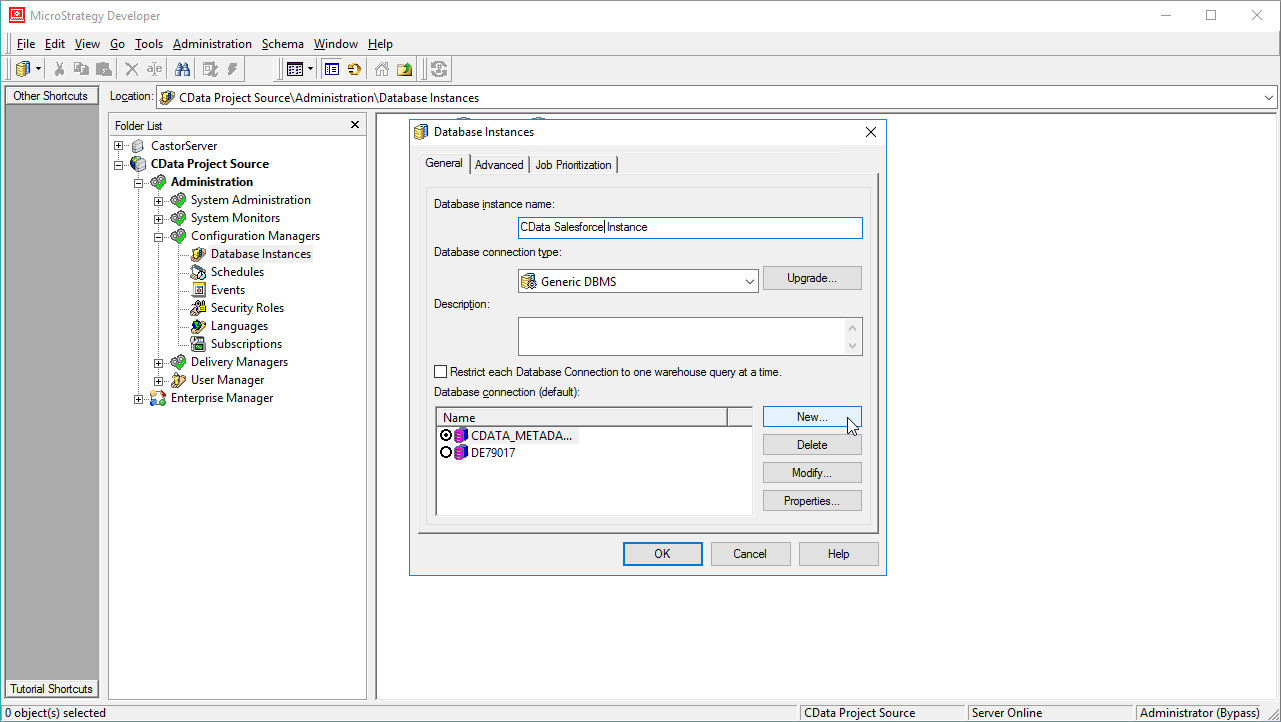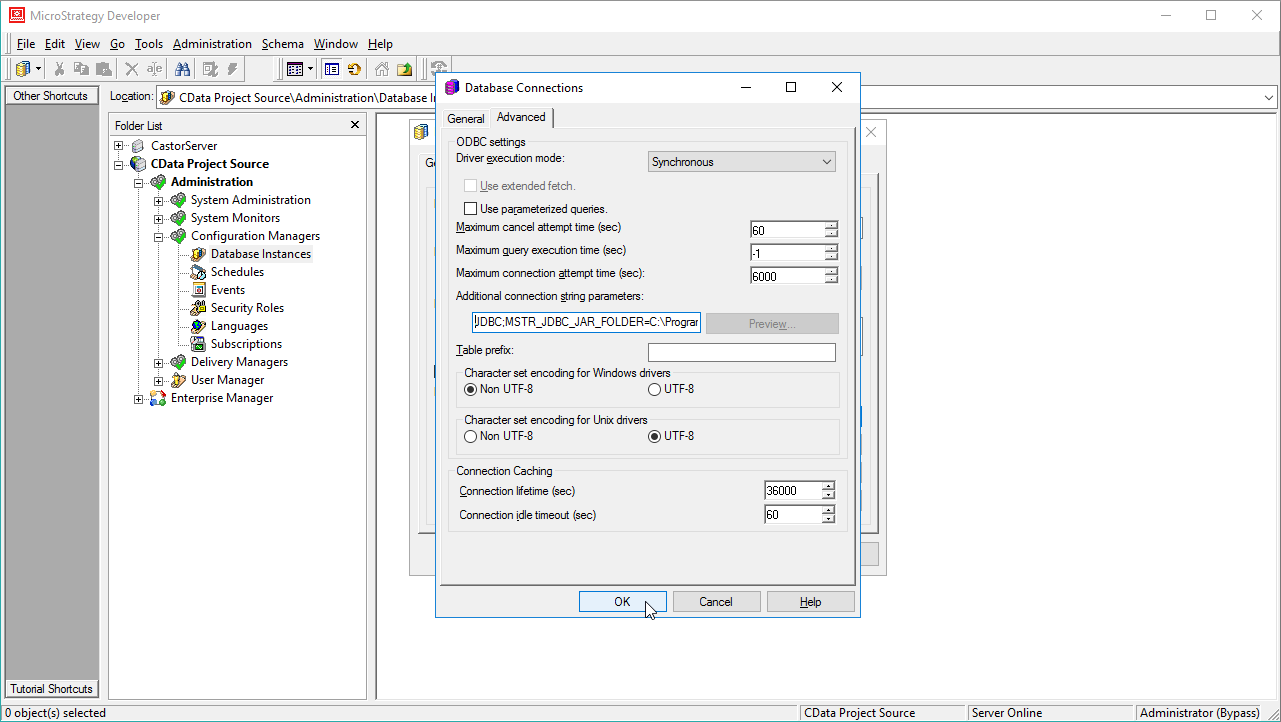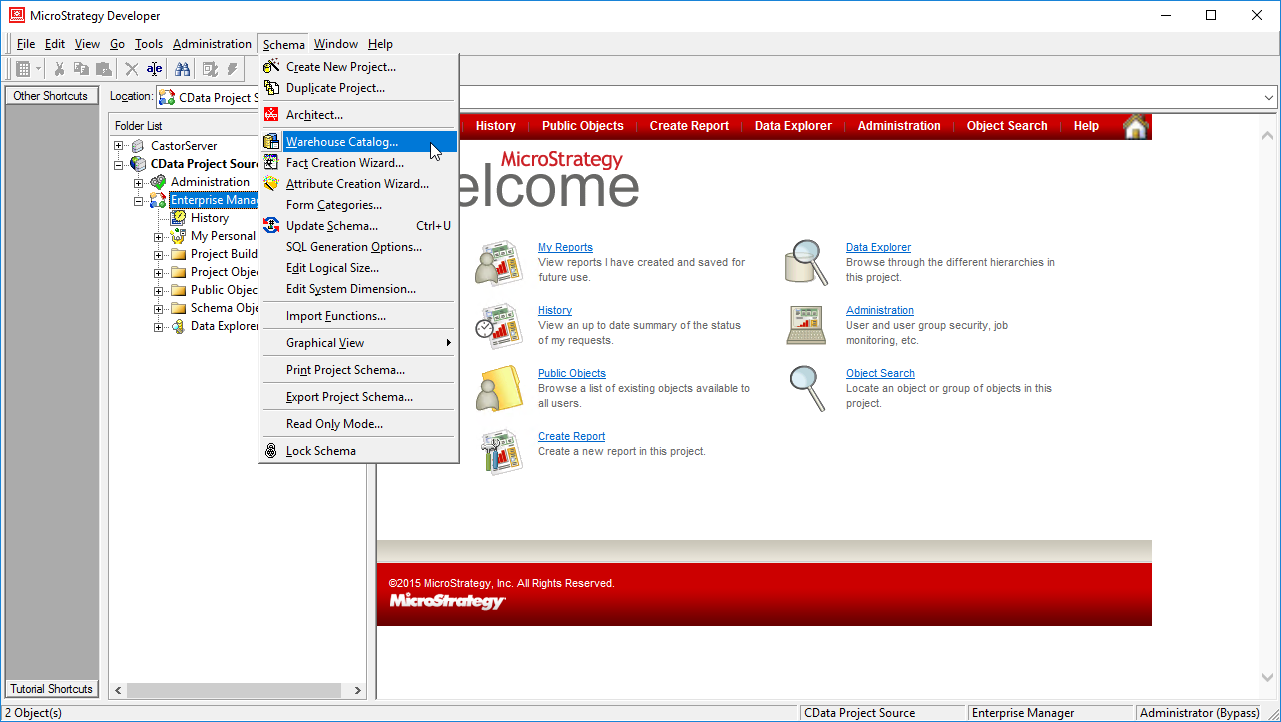Discover how a bimodal integration strategy can address the major data management challenges facing your organization today.
Get the Report →Use the CData JDBC Driver for Authorize.Net in MicroStrategy
Connect to Authorize.Net data in MicroStrategy Developer using the CData JDBC Driver for Authorize.Net.
MicroStrategy is an analytics and mobility platform that enables data-driven innovation. When you pair MicroStrategy with the CData JDBC Driver for Authorize.Net, you gain database-like access to live Authorize.Net data from MicroStrategy, expanding your reporting and analytics capabilities. In this article, we walk through creating a database instance for Authorize.Net in MicroStrategy Developer and create a Warehouse Catalog for the Authorize.Net data.
The CData JDBC Driver offers unmatched performance for interacting with live Authorize.Net data in MicroStrategy due to optimized data processing built into the driver. When you issue complex SQL queries from MicroStrategy to Authorize.Net, the driver pushes supported SQL operations, like filters and aggregations, directly to Authorize.Net and utilizes the embedded SQL engine to process unsupported operations (often SQL functions and JOIN operations) client-side. With built-in dynamic metadata querying, you can visualize and analyze Authorize.Net data using native MicroStrategy data types.
Connect to Authorize.Net in MicroStrategy Developer
You can connect to Authorize.Net in MicroStrategy Developer by adding a database instance based on the CData JDBC Driver for Authorize.Net.* Before you begin, you will need to install the JDBC Driver for Authorize.Net on the machine hosting the MicroStrategy Intelligence Server that your instance of MicroStrategy Developer is connected to.
- Open MicroStrategy Developer and select a Project Source.
- Navigate to Administration -> Configuration Managers -> Database Instances and right-click to add a new instance.
![Create a new Database Instance]()
- Name the instance, select Generic DBMS as the database connection type, and create a new database connection.
![Create a new database connection.]()
- In the database connection wizard, name the connection and create a new Database Login name, setting the user and password for Authorize.Net.
![Create a new database login.]()
- On the Advanced tab for the connection wizard, set the additional connection string parameters as follows.
- Add the JDBC keyword to the connection string.
- Set MSTR_JDBC_JAR_FOLDER to the path of the directory containing the JAR file for the JDBC driver. (C:\Program Files\CData JDBC Driver for Authorize.Net\lib\ on Windows.)
- Set DRIVER to cdata.jdbc.authorizenet.AuthorizeNetDriver, the driver class.
- Set URL to the JDBC URL for the Authorize.Net driver, which contains the necessary connection properties.
You can obtain the necessary connection properties on the Security Settings -> General Settings page after logging into your Merchant Account.
- UseSandbox: The Authorize.Net API to be used to process transactions. If you are using a production account, this property can be left blank. If you are using a developer test account, set this to 'TRUE'.
- LoginID: The API login Id associated with your payment gateway account. This property is used to authenticate that you are authorized to submit website transactions. Note that this value is not the same as the login Id that you use to log in to the Merchant Interface.
- TransactionKey: The transaction key associated with your payment gateway account. This property is used to authenticate that you are authorized to submit website transactions.
Built-in Connection String Designer
For assistance in constructing the JDBC URL, use the connection string designer built into the Authorize.Net JDBC Driver. Either double-click the JAR file or execute the jar file from the command-line.
java -jar cdata.jdbc.authorizenet.jarFill in the connection properties and copy the connection string to the clipboard.
![Using the built-in connection string designer to generate a JDBC URL (Salesforce is shown.)]()
When you configure the JDBC URL, you may also want to set the Max Rows connection property. This will limit the number of rows returned, which is especially helpful for improving performance when designing reports and visualizations.
Typical additional connection string properties follow:
JDBC;MSTR_JDBC_JAR_FOLDER=PATH\TO\JAR\;DRIVER=cdata.jdbc.authorizenet.AuthorizeNetDriver;URL={jdbc:authorizenet:LoginId=MyLoginId;TransactionKey=MyTransactionKey;};![Configuring the connection to Authorize.Net data using JDBC.]()
- Ensure that you have not selected an ODBC data source (this will trigger MicroStrategy to use the additional connection string parameters to build the database instance) and click OK.
- Click OK to close the database instance wizard.
- In the Project Source, right-click the project and open the Project configuration.
- Navigate to Database Instances, select the newly created database instance, and click OK.
![Adding the new database instance to the project.]()
- Close MicroStrategy Developer and restart the connected MicroStrategy Intelligence Server to complete the database instance creation.
With the database instance configured, you will now be able to connect to Authorize.Net data from the Warehouse Catalog and Data Import.
Connect to Authorize.Net Data from the Warehouse Catalog
Once you have created a database instance based on the JDBC Driver for Authorize.Net, you can connect to data from the Warehouse Catalog.
- Select your project and click Schema -> Warehouse Catalog.
![Creating the Warehouse Catalog]()
- In the Read Settings for the Catalog, click Settings and set the queries to retrieve the schema:
- To retrieve the list of tables, use the following query:
SELECT * FROM SYS_TABLES - To retrieve the list of columns for selected tables, use the following query:
SELECT DISTINCT CatalogName NAME_SPACE, TableName TAB_NAME, ColumnName COL_NAME, DataTypeName DATA_TYPE, Length DATA_LEN, NumericPrecision DATA_PREC, NumericScale DATA_SCALE FROM SYS_TABLECOLUMNS WHERE TableName IN (#TABLE_LIST#) ORDER BY 1,2,3
![Custom metadata queries.]()
- To retrieve the list of tables, use the following query:
- Select tables to be used in the project.
![Selecting tables to be used in the project.]()
Using the CData JDBC Driver for Authorize.Net in MicroStrategy, you can easily create robust visualizations and reports on Authorize.Net data. Read our other articles on connecting to Authorize.Net in MictroStrategy Web and connecting to Authorize.Net in MicroStrategy Desktop for more information.
Note: Connecting using a JDBC Driver requires a 3- or 4-Tier Architecture.















